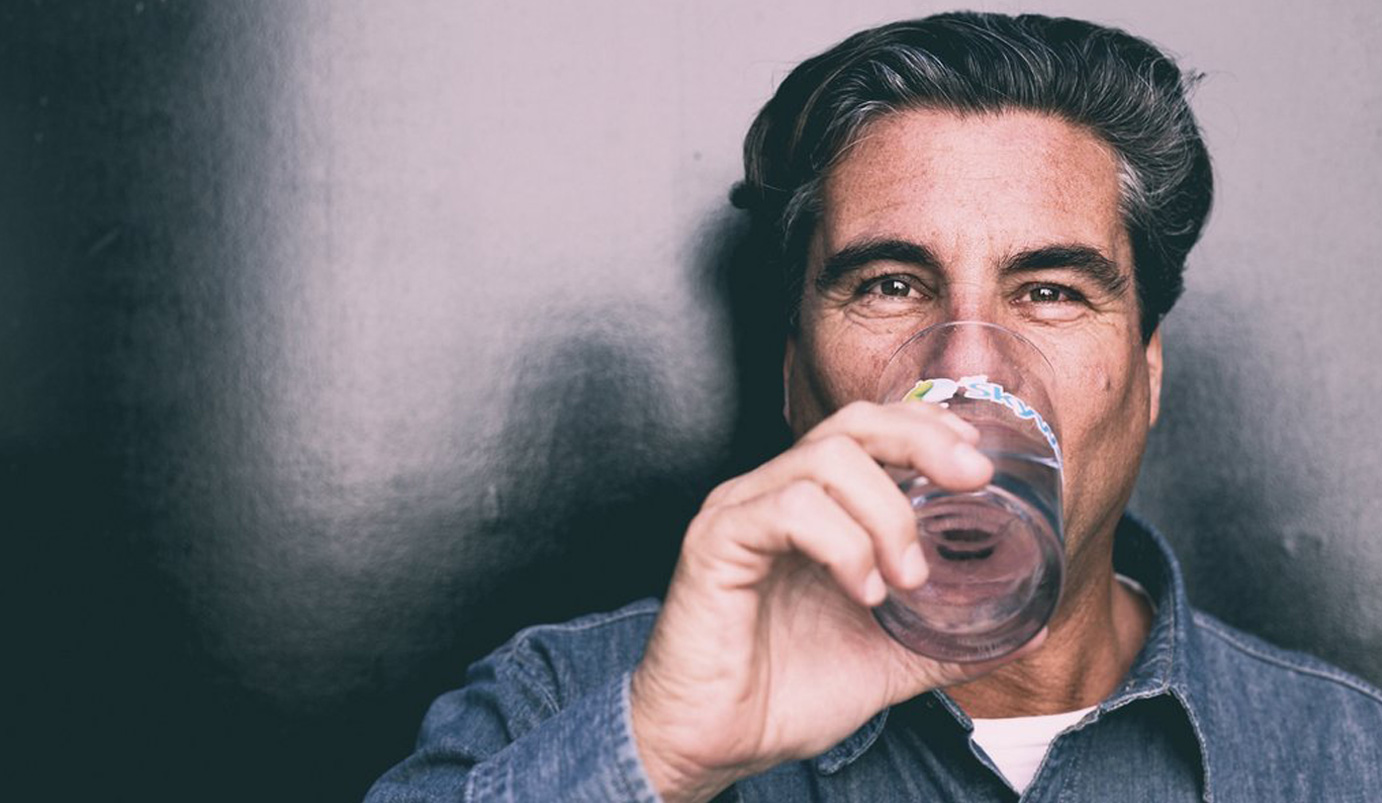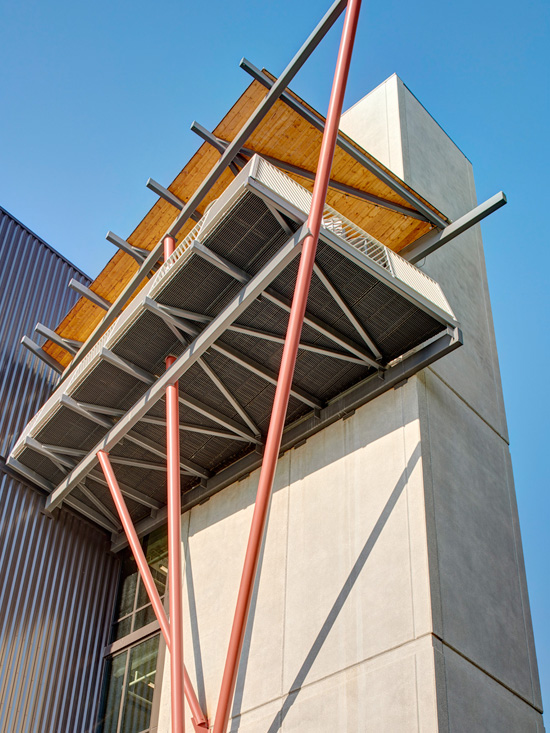Written by Louis Postel April 19, 2019

David Hertz uses innovative and unusual materials to create beautiful and environmentally conscious designs.
Discover how Hertz has integrated an air to water technology called ‘Skysource’ to produce up to 150 gallons of water per day.
For a miracle machine, capable of nudging humanity back from the rocky ledge of eco-suicide, it looks inauspicious—like a fridge with waffle-like filters finning the air. It’s the kind of thing Sears will gladly remove and replace.
But hold on!
There’s something going on with this machine: it makes water from air, lots of water, using solar and refrigeration technology to suck it down like a straw in the heavens. Prices range from $1,400 for the 14-gallon per day office model to $28,000 for the 300-gallon behemoth.
Nice to know, but what does this have to do with architecture?
Plenty, according to David Hertz FAIA of Venice, California, who owns Sky Source, manufacturer of the machines, which are shipped around the world from his factories in Hyderabad, India.
“For the past thirty-five years, I’ve been working to go beyond sustainability, toward a restorative and regenerative architecture,” he says. “While I don’t like how invasive buildings are on the environment, I love building.”
That’s the paradox Hertz has spent a year trying to resolve; the ultimate challenge of reversing the impact of his own profession—designing buildings beyond LEED certification, to a net positive relationship with the world.
Now with water from the sky, which contains more water than all the rivers on earth, cholera-plagued Haiti will not only have medical grade water, a project in partnership with screenwriter Scott Fifer’s celebrity-backed Go Campaign, but it will also have solar-powered buildings that feed the hungry, clad with well-irrigated vegetative surfaces, with all sewage treated and reused as fertilizer.
“Imagine an air-to-air heat pump whose main function is to transfer air into water rather than heat,” says Hertz. He first heard about the water-generating magic machine from a client who turned him on to its Miami-based inventor Richard Groden. Groden had taken his Sky Water company public just as the recession hit in 2008. The company quickly ran out of steam, and the entrepreneur retired to Miami.
This is already good news for Hertz’s residential clients in drought-stricken Santa Barbara, paying $5,000 per month in fines just to keep their trees alive. Good news too for the slum-dwellers of Hyderabad who now have free access to water stations at the base of the columns supporting Sky Source billboards, for the citizens out west whose new city office addition is well on its way to meeting the Living Building Challenge “efficient as a flower,” and for the members of the Open Temple in Venice, California, who draw water from Sky Source cistern to fill towers growing squash, cucumbers, butter lettuce, collard greens for the Sabbath.
“I am a water and tea person and when things taste yucky I’m the first to know it,” says Open Temple’s Rabbi Lori Shapiro about Sky Source water. “I first got a taste of it from a spigot Hertz had set up for all the homeless people living on the boardwalk here. It was the most delicious water I have ever tasted. It’s like putting a straw in the sky to drink. And for growing food for our Sabbaths, Sky Source water’s like manna from heaven. We have a music studio here in the temple and occasionally you hear one of the musicians call out ‘Hey, Dude, want to drink some sky?’ They also tell me it’s a great pick-up line.”
Hertz’s twelve-person studio may be beachy and barefoot, but it’s busy in the pursuit of the restorative and regenerative; a pursuit which in many ways calls for the reinvention of the practice of architecture itself. As opposed to design clients seeking out a specialist, Hertz holds that the complexity of the challenges they face will call increasingly for a systems thinker, one who sees and understands the organic connectedness of all things: community, environment, health, and happiness. “Applying Sky Source’s adiabatic distillation technology feels more like a purer form of architecture than non-architecture: there’s a structure, a social benefit, and space making,” he says. “After all, from a historical perspective, the well, the fountain, have always played a central role in towns and cities.”
The studio’s busy, but for all that business there’s no conference table for laying out blueprints. Working with Archicad, Hertz invites clients and staffers to walk around his many projects in virtual reality. There’s a trophy design for the World Surfing League, a hotel in Venice, a resort in the Grenadines (prefabricated from reclaimed wood from an old pier in Borneo, then flat-packed in Java), and a launch control facility Hertz is designing for SpaceX rockets. In addition, there’s competing for a $1.75 million Water Abundance XPRIZE for a device that extracts a minimum of 2,000 liters of fresh water per day from the atmosphere using 100 percent renewable energy, at a cost of no more than 2 cents per liter.
As a systems thinker, young David Hertz didn’t have to look far for inspiration. His father, Robert, a surgeon, wrote three science fiction novels. One, Penumbra, imagines sunspots knocking out all systems on Earth. He was also collecting and championing modern art with his wife, Joanne, who joined him in founding the Museum of Modern Art (MOCA) in Los Angeles, as well as the fabled Gemini Graphics, which teamed with Robert Rauschenberg in 1967 in producing what was then the largest art print ever made: Booster, a 72-inch-tall lithograph/silkscreen self-portrait.
As a kid, David recalls seeing outside the car window rows and rows of 747 aircraft “desiccating in the desert.” Years later, in 2011, he persuaded some adventurous clients to buy one of the 357 million-dollar planes for $35,000, in order to clip its wings and use them as their new roof. He had the wings brought to the remote site by helicopter, saving money on gas for a truck and labor, floating the giant wings on steel frames over the glass walls of what’s now known to Arch Daily readers as the 747 Wing House. At dusk, the wings appear poised to lift off into the aerodynamically shaped mountain ranges surrounding the new Malibu home. “Aluminum aircraft takes so much energy to produce, we were glad to find another use for it,” says Hertz. “Though it took a while to convince Homeland Security and the FAA we weren’t a terrorist cell, but simply mining the waste steam.”
As a miner of waste streams, as a maker of water from the sky, Hertz is helping to resolve the paradox that continues to drive him, as well as many of his colleagues in his profession. How to use systemic thinking to turn the architecture he loves into a resource-maker, rather than taker. As for the aesthetics of Sky Source machine itself—just make sure Sears doesn’t cart it off to the fridge burial grounds by mistake. The thing’s bound to precipitate and none too soon.
You might also like:

More Articles:
Archicad
Customer Stories
Education
Industry News
Tips, Resources + Downloads
Webinar Recordings